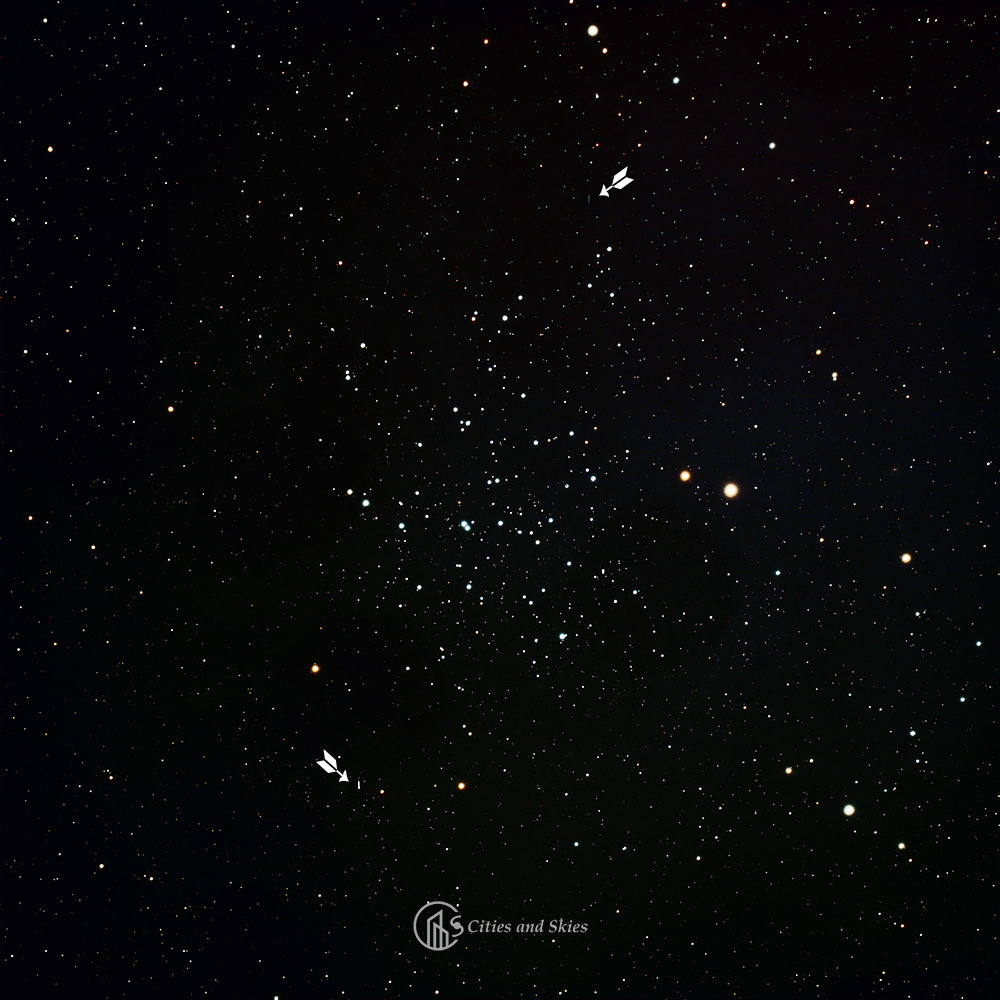The Pirate Moon Cluster is an open star cluster much more evolved than the ones in the Orion and the Rosette Nebula, and even the Pleiades. Designated with the number NGC 1647, this cluster is 150 million years old! What made it an interesting target this time is the fact that a minor planet was wandering through the cluster in late February 2021. Let the hunt for minor planets begin! Can you find it in the picture?
The hunt for Minor Planets
Minor planets are usually discovered by their motion relative to the background stars. If you make a long-exposure photo or a series of photos for a longer time, they will appear as elongated lines or little stars at different positions in each picture. This photo is a combination of 20 shots, each 5 minutes long. It may not be that straightforward to see a moving target in crowded fields, but this one, Psyche is quite well visible under the Pirate Moon Cluster, as we expected. There is another visitor in this image though, above the cluster. That one was a surprise to us! Checking the coordinates in the IAU Minor Planet Center, it turns out the only bright enough object wandering in the neighborhood is Sapientia. You may want to check it in a finer resolution image.
Asteroids
Most of the minor planets in the inner Solar System can be found between the orbit of Mars and Jupiter. These are called main-belt asteroids. Thus our hunt for minor planets ended up finding two asteroids in a single image! Of course, finding asteroids that have not been identified yet is hard work and dominantly done by larger telescopes. Asteroids have a (number), indicating the order of their discovery. Thus we have (16) Psyche and (257) Sapientia. A few days later we took another shot to see if our identification of the latter was correct. (257) Sapientia was supposed to cross the core of the Pirate Moon Cluster later. And it kind of did, as we found in our next imaging session. See if you can find it on this image! (Well, we told you a hunt for minor planets is hard!)
(16) Psyche, the ruined planet
(16) Psyche deserves a bit more attention because it is quite unique. It is composed of mainly metals, iron, and nickel. There is nothing like it with this high mass: 1% of the total mass of all minor planets in the region. Some believe it is the leftover core of a planet that was growing at the dawn of the Solar System. A crash with one or more planetesimals (building blocks of planets) however ripped it apart. Several iron-rich meteorites found on Earth are believed to be fragments from this cosmic encounter. NASA is planning to launch a space mission in 2022. The probe would visit (16) Psyche in 2026, for a period of 20 months. This is the (no longer used) symbol for Psyche: ![]()
Observing log
24 February 2021 – (16) Psyche was closest to the cluster a few days back but we never had a chance. Eventually beautiful clear night (till about midnight, then becoming less transparent). Moon close to full. Working in the back garden this time. The outside temperature is +15 C, but the camera still manages at -20 C (cooler ~80% working). Note (257) Sapientia was not trivial, it was not in the initial 5 arcmin search radius at the time of making the photo (it passed around there later). Finishing around 21:30 CET; shot the California Nebula later that night.
NGC1647 + (16) Psyche + (257) Sapientia, 20x300s
24 February 2021, Hoogeveen, Netherlands
William Optics GT81, f/5.9 with Flattener 6AIII 0.8x
ZWO ASI533MC-P, gain 101, -20 deg.
WO Uniguide 50/200 with ASI120MMmini
iOptron CEM40, ASIAir
Optolong L-pro
Astro Pixel Processor (trial version), Photoshop
27 February 2021 – Much colder than the past few days. Clear evening predicted, but with fog arriving around 1 am CET. Done a second run NGC 1647 Pirate Moon Cluster to check the nature of the second minor planet seen in the previous images. It looks it is indeed Sapientia. Starting around half-past seven. The second target this night is again the California Nebula.
NGC1647 + (257) Sapientia, 20x300s
27 February 2021, Hoogeveen, Netherlands
William Optics GT81, f/5.9 with Flattener 6AIII 0.8x
ZWO ASI533MC-P, gain 101, -20 deg.
WO Uniguide 50/200 with ASI120MMmini
iOptron CEM40, ASIAir
Optolong L-pro
Astro Pixel Processor (trial version), Photoshop
